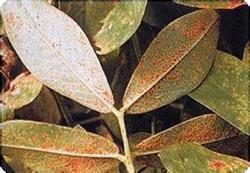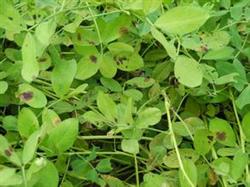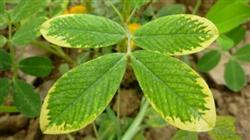What are the reasons for the occurrence and prevalence of peanut rust?

What are the reasons for the occurrence and prevalence of peanut rust? Peanut rust is a fungal disease caused by peanut stalk rust. The summer spores are yellow, round or nearly round, with micro-thorns on the surface, and there is a germination hole on each side of the middle part of the summer spores. Most summer spores produce only one germination tube, the appressorium is formed at the top of the germ tube, and the infection filaments invade peanut from the appressorium. Summer spores can germinate only when there are water droplets or water film. The ability to withstand low temperature is strong, but the ability to withstand high temperature is poor. In general, the germ tube invaded the tissue after 65 hours, and the hyphae continued to grow and produce haustorium. 7 days later, needle-tip-sized white spots appeared and began to produce summer spores. 8 days later, the white spots turned yellow-brown and formed a summer spore pile. 10 days later, the epidermis of the summer spore pile ruptured, sending out summer spores to continue infection. During the period of peanut growth, the spread of peanut rust was mainly caused by local bacteria, but the pathogen of early spring in northern peanut area also had the problem of non-local pathogens. The main factors affecting the occurrence and prevalence of peanut rust are: first, the amount of overwintering wormwood. If the amount of overwintering bacteria is large, peanut rust may occur in the following year. Second, climatic conditions. In general, temperature is not a limiting factor. The main factors affecting the prevalence of rust were Rain Water and fog dew. The occurrence of rust was serious because of more days of rainfall and fog dew. The third is cultivation and management. Spring peanut early sowing disease is mild, late sowing disease is serious; autumn peanut early sowing disease is serious, late sowing disease is mild; continuous cropping land disease is serious, rotation land disease is mild; paddy field occurrence is serious, dry field occurrence is light. The disease was serious in the fields with partial application of nitrogen fertilizer.
- Prev

How to prevent and cure the purple feather disease of peanut?
How does peanut leaf spot happen? Peanut black spot and brown spot are diseases caused by fungi. The sexual generation of peanut black spot pathogen is Berkeley coccidiomycetes; aspergillum hemispherical, brown to black, buried under the host epidermis, conidiophores; terminal conidia, conidia olive.
- Next

How does peanut sheath blight occur? How to prevent and cure?
How does peanut sheath blight occur? How to prevent and cure? (1) incidence regularity: peanut sheath blight is a disease caused by basidiomycetes. The young hyphae are colorless and yellowish brown when mature; they are branched, constricted obviously at the branches, and there is a septum not far from the branches. The hyphae on the surface of the diseased tissue can form sclerotia, sclerotia table.
Related
- The first cup of black tea in spring, the flavor and history of tea gardens in Kenya, Africa
- The computer can not only choose potatoes, but also grow tea rice. AI will grow winter oolong tea champion.
- It is not only the inflated tea bitten by insects, but also engraved with the four seasons tea in Beipu.
- The Oriental Beauty Tea Festival in Zhuxian County takes the stage at the weekend to experience the plus-size feast of oil tea.
- & quot; Oriental Beauty Tea & Exploration of Emei in Hsinchu, the hometown of quot;
- The new variety of strawberry "Tainong 1" dessert is the first choice with mellow aroma. Crimson gorgeous
- History of Tea in Taiwan: from Wild Inner Mountain to Export Tea Garden
- Two types of Taiwan Oriental Beauty Black Tea won the British three-Star Award for Childhood Tea Xiang Zhang Jiaqi changed from pilot to champion tea maker.
- Banana species and varieties: the planting history of Taiwan Xianren banana and dwarf banana is long, is banana disease resistant?
- Coffee planting Technology: Qianjie Coffee from Seedling to harvesting

